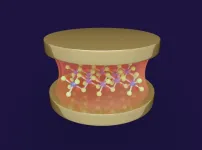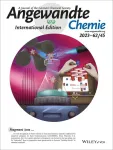(Press-News.org) An international research team involving Dr. Olga Kocharovskaya , a distinguished professor in the Department of Physics and Astronomy at Texas A&M University, has taken a major step toward development of a new generation of atomic clocks with mind-blowing potential affecting fundamental science and various industries, from nuclear physics to satellite navigation and telecommunications.
The team’s work, led by Argonne National Laboratory senior physicist Dr. Yuri Shvyd'ko, for the first time resonantly excited the scandium-45 nuclear isomer with the world's brightest X-ray pulses at the European XFEl (EuXFEL) X-ray laser facility and determined the position of this nuclear resonance with unprecedented accuracy. Their findings are reported in the journal Nature, both online and in the Oct. 19 print edition.
“Atomic clocks, such as the caesium-133 clock or the strontium-87 clock, rely on oscillations of electrons in an atom, which can oscillate at highly reliable frequencies when excited by microwave or optical radiation,” explained Kocharovskaya, principal investigator of the National Science Foundation (NSF) project that initiated and supported this research.
Scandium, an element used in aerospace components and sports equipment, enables an accuracy of one second in 300 billion years, or roughly a thousand times more precision than the current standard atomic clock. The combination of scandium-45 and ultra-bright X-ray pulses brings scientists a decisive step closer to creation of the first-ever nuclear clock that could harness the oscillation of the atomic nucleus rather than its electron shell.
“For purposes that demand such precision, including the study of certain aspects of relativity, gravitational theory and other physical phenomena such as dark matter, the nuclear clock is the ultimate timepiece," said Dr. Xiwen Zhang, a postdoctoral researcher in Kocharovskaya's group who co-authored the paper.
With their accuracy of up to one part in 10,000,000,000,000,000,000, Texas A&M physicist Dr. Grigory V. Rogachev notes that nuclear clocks could usher in a new era of precision timekeeping and enable transformative applications in myriad areas, resulting in a host of applications and advances.
”Humanity has been on the lookout for the technology to make the most precise clocks since the dawn of the modern ages,” said Rogachev, head of Texas A&M Physics and Astronomy and a member of the Texas A&M Cyclotron Institute. “At present, atomic clocks are the best. Dr. Kocharovskaya and her collaborators are now making the first step toward a new, breakthrough technology. Her research opens a new pathway to utilize the unique properties of the scandium-45 isotope to create the most precise clock ever — the nuclear clock. This advancement may have exciting applications in extreme metrology, ultra-high spectroscopy and potentially numerous other fields.”
Kocharavskaya’s research interests during the past decade have been focused on extending the field of traditional quantum optics — which she describes as dealing with controllable resonant interactions between optical photons and atomic transitions — into the emerging field of nuclear/x-ray quantum optics focused on control of resonant interaction between x-ray photons and nuclear transitions. In the process, she identified scandium-45 with its long-lived first-excited energy state as the superior candidate both for quantum nuclear storage and the nuclear clock. The main question, she says, was whether it was feasible to reach this state with available x-ray sources.
Together with Shvyd’ko, who had envisioned the high potential of scandium-45 for super-resolution-coherent-forward nuclear spectroscopy along with a possibility of its resonant excitation by X-rays from an emerging new generation of accelerator-based facilities 30 years ago, Kocharovskaya wrote a proposal to the NSF aimed at resonant excitation of a scandium-45 nuclear isomer using X-ray pulses.
“Initially it received mixed reviews, as it was considered a high-risk/high payoff project, but eventually, it was funded, allowing us to plan the experiment at EuXFEL,” said Kocharovskaya, a member of the Texas A&M Institute for Quantum Science and Engineering.
Kocharovskaya credits Shvyd'ko as not only the leader of the group’s research but also an inspiration for the entire team. From coordinating the efforts of all the groups entering every detail of the project to running weekly Zoom meetings discussing the multiple challenges and progress in preparation for the experiment, she says his leadership and hard work provided a tangible example of precisely what it means to see a long-term scientific dream become a reality. In addition, she notes that the project would not be successful without the major contributions of their German colleagues: Dr. Ralf Röhlsberger at DESY and the Helmholtz Institute, Jena; Dr. Jörg Evers at the Max Planck Institute for Nuclear Physics, Heidelberg; and Drs. Anders Madsen and Gianlcuca Geloni at EuXFEL, along with the groups they each lead.
“As soon as the resonance was seen within the first several hours of the data collection, we all joyfully celebrated this success,” she added. “It was rewarding for all of us, but especially for Yuri, who realized a high scientific potential of scandium-45 for super-resolution nuclear spectroscopy and the possibility to excite it with modern accelerator-based X-ray sources 33 years ago.”
Never one to rest on their laurels, the team already is focused on next steps and goals, starting with determining the resonant transition energy with even higher accuracy and measuring the exact lifetime of an isomer state. In addition, there’s also observation of the coherent forward nuclear scattering and measuring the linewidth of the nuclear transition.
“The next two steps can be achieved in a relatively simple way,” Zhang acknowledged. “While the third step is extremely challenging, it's absolutely critical in order to estimate a projected accuracy and stability of any future nuclear clock. As a group and as a broader research team, we all look forward to the challenge.”
An international research team involving Dr. Olga Kocharovskaya , a distinguished professor in the Department of Physics and Astronomy at Texas A&M University, has taken a major step toward development of a new generation of atomic clocks with mind-blowing potential affecting fundamental science and various industries, from nuclear physics to satellite navigation and telecommunications.
The team’s work, led by Argonne National Laboratory senior physicist Dr. Yuri Shvyd'ko, for the first time resonantly excited the scandium-45 nuclear isomer with the world's brightest X-ray pulses at the European XFEl (EuXFEL) X-ray laser facility and determined the position of this nuclear resonance with unprecedented accuracy. Their findings are reported in the journal Nature, both online and in the Oct. 19 print edition.
“Atomic clocks, such as the caesium-133 clock or the strontium-87 clock, rely on oscillations of electrons in an atom, which can oscillate at highly reliable frequencies when excited by microwave or optical radiation,” explained Kocharovskaya, principal investigator of the National Science Foundation (NSF) project that initiated and supported this research.
Scandium, an element used in aerospace components and sports equipment, enables an accuracy of one second in 300 billion years, or roughly a thousand times more precision than the current standard atomic clock. The combination of scandium-45 and ultra-bright X-ray pulses brings scientists a decisive step closer to creation of the first-ever nuclear clock that could harness the oscillation of the atomic nucleus rather than its electron shell.
“For purposes that demand such precision, including the study of certain aspects of relativity, gravitational theory and other physical phenomena such as dark matter, the nuclear clock is the ultimate timepiece," said Dr. Xiwen Zhang, a postdoctoral researcher in Kocharovskaya's group who co-authored the paper.
With their accuracy of up to one part in 10,000,000,000,000,000,000, Texas A&M physicist Dr. Grigory V. Rogachev notes that nuclear clocks could usher in a new era of precision timekeeping and enable transformative applications in myriad areas, resulting in a host of applications and advances.
”Humanity has been on the lookout for the technology to make the most precise clocks since the dawn of the modern ages,” said Rogachev, head of Texas A&M Physics and Astronomy and a member of the Texas A&M Cyclotron Institute. “At present, atomic clocks are the best. Dr. Kocharovskaya and her collaborators are now making the first step toward a new, breakthrough technology. Her research opens a new pathway to utilize the unique properties of the scandium-45 isotope to create the most precise clock ever — the nuclear clock. This advancement may have exciting applications in extreme metrology, ultra-high spectroscopy and potentially numerous other fields.”
Kocharavskaya’s research interests during the past decade have been focused on extending the field of traditional quantum optics — which she describes as dealing with controllable resonant interactions between optical photons and atomic transitions — into the emerging field of nuclear/x-ray quantum optics focused on control of resonant interaction between x-ray photons and nuclear transitions. In the process, she identified scandium-45 with its long-lived first-excited energy state as the superior candidate both for quantum nuclear storage and the nuclear clock. The main question, she says, was whether it was feasible to reach this state with available x-ray sources.
Together with Shvyd’ko, who had envisioned the high potential of scandium-45 for super-resolution-coherent-forward nuclear spectroscopy along with a possibility of its resonant excitation by X-rays from an emerging new generation of accelerator-based facilities 30 years ago, Kocharovskaya wrote a proposal to the NSF aimed at resonant excitation of a scandium-45 nuclear isomer using X-ray pulses.
“Initially it received mixed reviews, as it was considered a high-risk/high payoff project, but eventually, it was funded, allowing us to plan the experiment at EuXFEL,” said Kocharovskaya, a member of the Texas A&M Institute for Quantum Science and Engineering.
Kocharovskaya credits Shvyd'ko as not only the leader of the group’s research but also an inspiration for the entire team. From coordinating the efforts of all the groups entering every detail of the project to running weekly Zoom meetings discussing the multiple challenges and progress in preparation for the experiment, she says his leadership and hard work provided a tangible example of precisely what it means to see a long-term scientific dream become a reality. In addition, she notes that the project would not be successful without the major contributions of their German colleagues: Dr. Ralf Röhlsberger at DESY and the Helmholtz Institute, Jena; Dr. Jörg Evers at the Max Planck Institute for Nuclear Physics, Heidelberg; and Drs. Anders Madsen and Gianlcuca Geloni at EuXFEL, along with the groups they each lead.
“As soon as the resonance was seen within the first several hours of the data collection, we all joyfully celebrated this success,” she added. “It was rewarding for all of us, but especially for Yuri, who realized a high scientific potential of scandium-45 for super-resolution nuclear spectroscopy and the possibility to excite it with modern accelerator-based X-ray sources 33 years ago.”
Never one to rest on their laurels, the team already is focused on next steps and goals, starting with determining the resonant transition energy with even higher accuracy and measuring the exact lifetime of an isomer state. In addition, there’s also observation of the coherent forward nuclear scattering and measuring the linewidth of the nuclear transition.
“The next two steps can be achieved in a relatively simple way,” Zhang acknowledged. “While the third step is extremely challenging, it's absolutely critical in order to estimate a projected accuracy and stability of any future nuclear clock. As a group and as a broader research team, we all look forward to the challenge.”
END
Texas A&M physicists play key role in milestone moment toward development of nuclear clock
2023-11-03
ELSE PRESS RELEASES FROM THIS DATE:
Wake Forest Institute for Regenerative Medicine (WFIRM) secures National Science Foundation (NSF) grant renewal for summer undergraduate research program
2023-11-03
WINSTON-SALEM, NC – November 3, 2023 - The Wake Forest Institute for Regenerative Medicine (WFIRM) is thrilled to announce the successful renewal of its Research Experiences for Undergraduates (REU) Site grant from the National Science Foundation (NSF). The grant, titled "Enabling Technologies and New REU Approaches to Engineer Complex Tissues" will continue to offer diverse cohorts of undergraduate students unique research, education, and professional development opportunities in the multidisciplinary field of regenerative medicine (RM) over ...
U of M Medical School research team finds novel drug improves outcomes for patients with rare kidney disorder
2023-11-03
MINNEAPOLIS/ST. PAUL (11/03/2023) — Focal segmental glomerulosclerosis (FSGS) is a rare kidney disorder that affects children and adults, and can lead to kidney failure. New findings from a team led by the University of Minnesota Medical School show patients with FSGS who were treated with the medication sparsentan experienced improved kidney function—making it a potential new treatment option for the disorder.
The research, published today in the New England Journal of Medicine, suggests sparsentan may provide kidney protection by significantly reducing excess protein in urine — known as proteinuria, a proven indicator of kidney damage.
“FSGS ...
Opioid disorder treatment: first three weeks forecast success
2023-11-03
NEW YORK, NY--A newly developed prediction model may be able to calculate the risk of opioid relapse among individuals in the early stages of medication treatment—as early as three weeks into therapy.
“Medication treatment for opioid use disorder, contrary to popular belief, is very effective and likely to succeed if patients achieve early treatment success,” says Sean X. Luo, MD, PhD, assistant professor of psychiatry at Columbia University Vagelos College of Physicians and Surgeons, who ...
Study links childhood trauma to COVID-19 deaths, hospitalizations
2023-11-03
People who endured childhood adversity, like abuse or neglect, were more likely to be hospitalized or die from COVID-19 in adulthood, a new University of Pittsburgh study found. Specifically, higher self-reported childhood adversity was linked to 12-25% higher odds of COVID-19 hospitalization and mortality.
While age, sex, ethnicity, health, and sociodemographic factors have been related to such outcomes throughout the pandemic, this was the first study finding a link between these COVID-19 outcomes ...
America’s low-carbon transition could improve employment opportunities for all
2023-11-03
The USA is likely to see consistent job growth from the transition to net zero, but the gains will be unevenly distributed, shows a new analysis.
The analysis, conducted by Imperial College London researchers and published today in Nature Climate Change, shows that some states will need new policies to ensure a ‘just’ transition.
The USA, alongside many countries, is planning for a low-carbon future, where energy production releases little to no carbon dioxide and what is released is removed from the atmosphere, creating net-zero carbon emissions. This has been backed by new policies, including the 2022 Inflation Reduction Act, which includes large investment ...
Expanding pharmacists’ role for patients with hypertension could prevent 15 million heart attacks and save $1.1 trillion over 30 years, VCU-led study finds
2023-11-03
RICHMOND, Va. (Nov. 3, 2023) — If pharmacists had a larger role in prescribing medications to control blood pressure, they could prevent more than 15 million heart attacks, nearly 8 million strokes and more than 4 million cases each of angina and heart failure in the U.S. over 30 years, according to a new Virginia Commonwealth University-led study.
The study, “Cost-Effectiveness of Pharmacist Prescribing for Managing Hypertension in the United States,” which published Friday in JAMA Network Open, details how ...
Black and white adults have similar health care expenditure levels in racially and economically integrated communities
2023-11-03
Differences in health care expenditures between Black and white adults vary substantially with the local level of racial and economic integration, and tend to be low or nonexistent in highly integrated communities, according to a study led by researchers at the Johns Hopkins Bloomberg School of Public Health.
For their study, the researchers compared health care expenditures for a nationally representative sample of Black and white adults in census tracts across the United States. They found that, at the same level of health, health ...
Effect of a novel multicomponent intervention to improve patient access to kidney transplant and living kidney donation
2023-11-03
About The Study: A novel multicomponent intervention designed to target several barriers that prevent eligible patients from completing key steps toward receiving a kidney transplant did not significantly increase the rate of completed steps in this randomized clinical trial that included 20,375 patients from 26 chronic kidney disease programs. Improving access to transplantation remains a global priority that requires substantial effort.
Authors: Amit X. Garg, M.D., Ph.D., of McMaster ...
Vacuum in optical cavity can change material’s magnetic state without laser excitation
2023-11-03
Researchers in Germany and the USA have produced the first theoretical demonstration that the magnetic state of an atomically thin material, α-RuCl3, can be controlled solely by placing it into an optical cavity. Crucially, the cavity vacuum fluctuations alone are sufficient to change the material’s magnetic order from a zigzag antiferromagnet into a ferromagnet. The team’s work has been published in npj Computational Materials.
A recent theme in material physics research has been the use of intense laser light to modify the properties ...
Charged “molecular beasts” the basis for new compounds
2023-11-03
Developing new ways to break and reform chemical bonds is one of the main tasks of basic chemical research. “When a bond in a charged molecule is broken, the result is often a chemically ‘aggressive’ fragment, which we call a reactive fragment. These fragments are difficult to control using established methods of chemical synthesis. You can think of them as untamed beasts that attack anything in their path. In a mass spectrometer, there are many ways to break certain bonds and generate fragments,” says Dr Warneke, describing the processes in mass spectrometers. According ...



